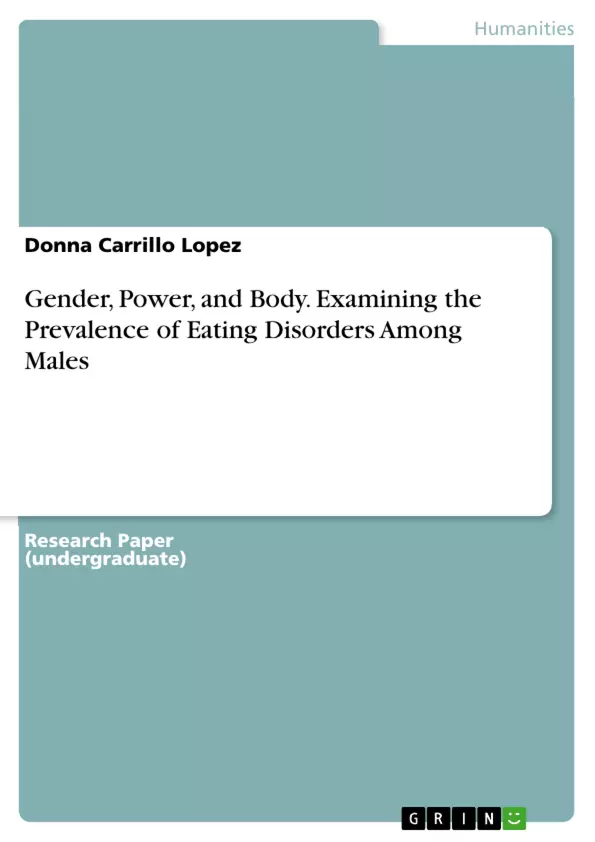Over the past few decades of research and practice on eating disorders, there has been a severe lack of focus on the prevalence of these disorders among male populations. Given that an estimated 25-40% of males suffer from eating disorders, it is important for research and practice to adopt a nuanced understanding of how and why males are affected by these disorders.
This paper provides an analytical lens for understanding the influence of gender and power dynamics in the occurrence of eating disorders among males. By exploring how gender and power manifest on the individual level to influence self-perception and body image, the hope is that this study may contribute to a more nuanced perspective of relevant issues and appropriate methods for prevention, diagnosis, and treatment.
Inhaltsverzeichnis (Table of Contents)
- Abstract
- Introduction
- A Brief History of Eating Disorders (ED)
- Prevalence of Eating Disorders Among Males
- Perspectives on Gender and Food – Feminism, Post-Feminism, and Masculinity
- Power and the Body - Bourdieu's Theory of Power Relations
- Understand Prevalence of ED Among Males Through a Lens of Gender and Power
- Conclusion
Zielsetzung und Themenschwerpunkte (Objectives and Key Themes)
This paper aims to provide an analytical framework for understanding the prevalence of eating disorders among males, focusing on the influence of gender and power dynamics. By examining how these dynamics manifest on an individual level, shaping self-perception and body image, the study seeks to contribute to a more nuanced perspective on eating disorders in men.
- The historical underrepresentation of males in eating disorder research and the implications for diagnosis and treatment.
- The impact of social and cultural ideals on the development of eating disorders among males, particularly the pressure to achieve a lean and muscular physique.
- The role of feminist and post-feminist theories in understanding how gender dynamics influence eating disorders, particularly in relation to body image and self-perception.
- The intersection of gender and power in shaping the prevalence of eating disorders among males, considering factors such as social norms, media representations, and the influence of masculinity.
Zusammenfassung der Kapitel (Chapter Summaries)
- Introduction: The paper highlights the lack of attention given to males in eating disorder research despite the fact that an estimated 25-40% of eating disorder patients are male. It emphasizes the importance of understanding how gender dynamics influence eating behaviors and perceptions related to body image.
- A Brief History of Eating Disorders (ED): This section delves into the historical development of eating disorder diagnoses, tracing the evolution of understanding from anorexia nervosa to bulimia nervosa and atypical eating disorders. It explores the influence of social and cultural factors on the emergence and prevalence of these disorders, particularly among women.
- Prevalence of Eating Disorders Among Males: The paper explores the underdiagnosis and stigmatization of eating disorders among males due to the historical focus on females. It highlights the prevalence of eating disorders in males and the unique challenges they face in seeking help and treatment. The section also discusses the rise of research on eating disorders in males and the need for further investigation into the specific factors that influence their experiences.
- Perspectives on Gender and Food – Feminism, Post-Feminism, and Masculinity: This chapter examines the application of feminist and post-feminist theories to understand the relationship between gender, power, and food. It emphasizes the importance of recognizing how gender dynamics influence perceptions, behaviors, and ideals surrounding food and body image.
Schlüsselwörter (Keywords)
The main keywords and focus topics of this paper include: eating disorders, gender, power, body image, self-perception, feminism, post-feminism, masculinity, prevalence, diagnosis, treatment, males, underdiagnosis, stigmatization, social norms, media representations, cultural ideals, and research bias.
- Citar trabajo
- Donna Carrillo Lopez (Autor), 2016, Gender, Power, and Body. Examining the Prevalence of Eating Disorders Among Males, Múnich, GRIN Verlag, https://www.grin.com/document/351769



